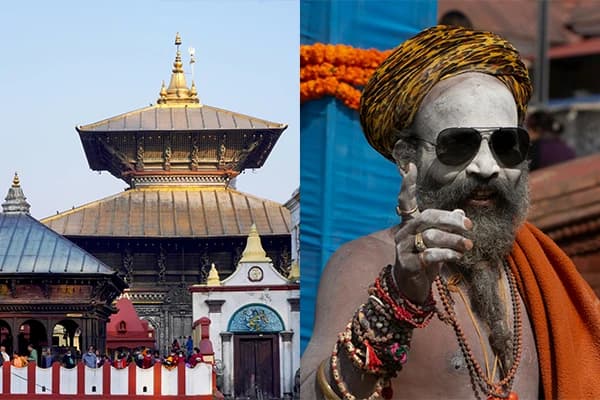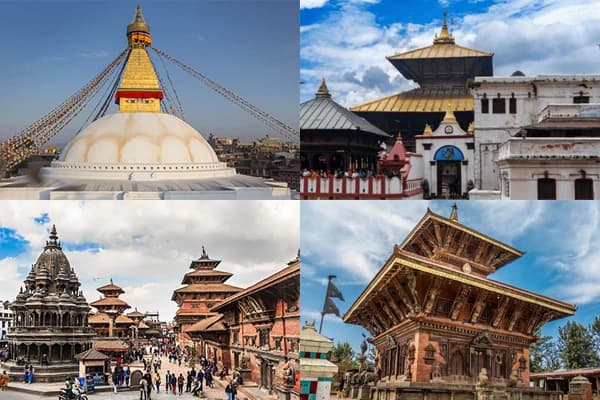Historical importance of the festival
The Krishna Janmashtami in Nepal has historical importance, and the festival is celebrated with great joy. The festival is linked to the old story of Krishna’s birth.
According to Hindu mythology, Lord Krishna was born to King Vasudev and Queen Devaki in Mathura. However, their evil cousin, Kansa, imprisoned them. The reason behind their imprisonment was the celestial announcement from the sky that Krishna, Devaki's eighth son, would kill him.
However, Krishna was born at midnight and his father managed to spirit him away to safety across the Yamuna River to Gokul. In Gokul, he exchanges Krishna with another baby girl who was the offspring of Krishna’s foster parents, Nanda and Yasoda.
That night, a miraculous event happened. The prison doors opened on their own, the guards felt asleep and also Vashudev’s shackles broke. The Yamuna River, despite becoming flooid, became shallow enough for Vashudev to cross with the baby Krishna. Those events signifies the triumph of good over evil and the presentation of Dharma.
Religious importance of the festival
The Krishna birthday date 2025 festival is religiously important in Nepalese society. The Lord Krishna is considered the eighth incarnation of Vishnu. According to Hindu mythology, Krishna was born to restore Dharma and eliminate Adharma. This story is summed in Krishna’s own word from the Bhagavad Gita: “Whenever there is a predominance of evil and a decline in righteousness, I will reincarnate to vanquish evil and uphold righteousness."
The festival not only marks Krishna’s birth but also serves as a reminder of his teachings in the Bhagavad Gita. The Bhagavat Gita addresses the complexities of life, duty, and morality. In Nepali tradition, the Krishna Janmashtami celebrates the Triumph of Good Over Evil as Krishna defeats numerous demons and tyrants, notably his maternal uncle Kansa.
Preparations for the Festival
Shri Krishna Janmashtami's special preparations include decorating the home and temple, preparing special dishes, performing rituals and prayers, and fasting and feasting.
-
Home and temple decorations
The first step in preparation is to decorate the house and temple. At first, the Aktar is set up in a clean and elevated space. And then the altar is adorned with fresh flowers, garlands, and decorative lights. The rangolis are made, lighting is placed, torans and banners are placed, and the jhulas are decorated.
Several dishes are prepared on the occasion of Shree Krishna Janmashtami. Some of the popular dishes include Makhan Mishri, Panchamrit, Malpua, Modak, and so on. These items are offered to Krishna with love and devotion at the stroke of midnight.
-
Performing rituals and prayers
The rituals and prayers are the main part of the Krishna Janmashtami celebrations. The idols of the deities are bathed with milk, yogurt, honey, ghee, and other auspicious liquids. Then, arti and kirtan (devotional songs and chanting Krishna names) are performed. The devotees who fast stay awake till midnight to welcome Krishna’s birth.
Devotees fast from grains, beans, onions, and garlic on Janmashtami day. Some devotees fast until midnight and break their fast with prasad (sanctified food). Also, the prepared feast of special dishes is offered to Krishna and shared with family and friends after the midnight aarti.
How is Krishna Janmashtami celebrated in Nepal?
The Shree Krishna Janmastami festival is celebrated with great sincerity and devotion across Nepal. The celebrations bring people together in their devotion to Lord Krishna.
Visits to and rituals at temples, singing and dancing, cultural events, temple decorations, and many other activities all take place on the festival day. The popular temples are the Krishna Mandir in Patan Durbar Square or the Krishna Temple in Kathmandu, where prayers are offered to god, rituals are performed, devotional songs are sung and various traditional dances are performed.
The midnight rituals are celebrations filled with devotion and cultural activities. Devotees engage in nightlong vigil, staying awake until midnight. The devotional songs like bhajans, chant slokas, and recount stories of Krishna's life are sung that night. Some of the popular bhajans are "Om Jai Jagdish Hare" and "Govinda Jai Jai", also available on YouTube.
The midnight rituals include Nishita Puja, Bathing the Idol, and Jhoola Ceremony. These rituals are carried out at night, along with other celebrations like singing and dancing.
Devotees practice two types of fasting during the festival: Nirjala fast and Phalahar fast. In Nirjala fast, the devotees don’t drink water and have food till midnight. While the Phalahar fast allows devotees to consume fruits like bananas, apples, and pomegranates, milk, yogurt, paneer, butter, potatoes, sweet potatoes, nuts, seeds, and water,.
The fasting ends in a feast at midnight after the rituals celebrating Krishna’s death. The feast known as prasad consists of traditional foods like Panchamrit, Makhan Mishri, laddoos, pedas, and various milk-based desserts shared among family members and friends.
The various cultural programs are conducted in order to celebrate Shree Krishna’s birth. The dramas and dances are performed, depicting Krishna’s life during Janmashtami. Some of the popular performances are Ras Leela, Krishna Lila, Manipuri Raas Leela, Sattriya Dance, and children's performances. In some places, the celebrations even lead to parades and processions.
Tips for the tourists attending the festival
- Try to visit the major celebation places like krishna mandir in patan and the iskcon Temple, budhanilkantha in Kathmandu to see the grand celebrations
- Ensure your travel plans align with the festival dates to experience the full range of celebrations
- Attend traditional performances like Raas Leela, which depict episodes from Krishna's life through dance and drama
- Book your stay well in advance to secure a comfortable place close to the festivities
- Dress modestly suitable for the temple visits
- Be mindful of local customs while participating the communal meals
- Interacting with local devotees can provide deeper insights into the significance of the festival
- Try combining the kathmandu heritage tour or kathmandu day tour to observe the celebations around the city.
Conclusion
Shree Krishna Janmashtami is an important Hindu festival celebrated all over Nepal. This festival marks the birth of Lord Krishna, the eighth avatar of Vishnu. Devotees celebrate the festival by engaging in rituals like fasting, prayers, and reciting sacred texts, staying awake until midnight.
The homes and temples are decorated during the festival. The cultural programs, including drama and dance, are performed. Overall, the festival emphasizes the triumph of good over evil, with devotees observing fasting, performing rituals, and sharing special feasts at midnight





